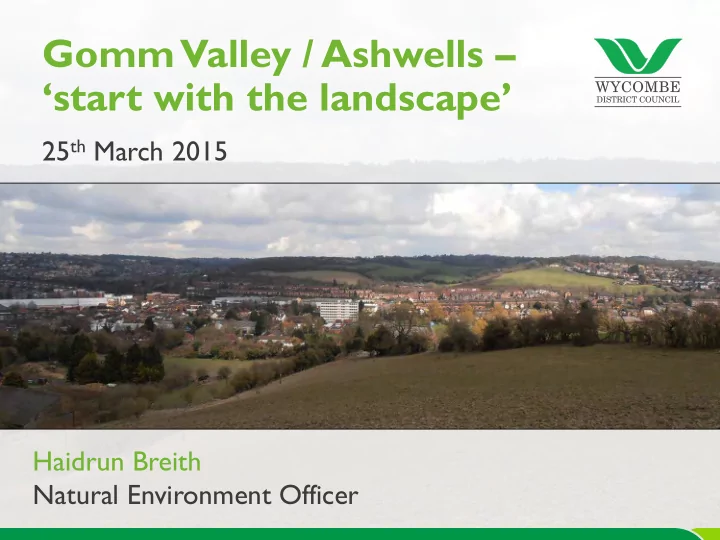

Gomm Valley / Ashwells – ‘start with the landscape’ 25 th March 2015 Haidrun Breith Natural Environment Officer
Introduction & role • One of three p/t Natural Environment Officers • Based in Spatial Planning (Environment & Infrastructure Team) • Advisory role to planning on issues relating to landscape and ecology
Contents: 1. Introduction into landscape / visual assessments processes 2. Gomm Valley / Ashwells landscape
Introduction into landscape / visual assessments processes 1. Landscape Character Assessments (LCA) 2. Landscape and Visual Impact Assessments (LVIA)
Landscape Character Assessments (LCA) • Landscape Character Assessment Guidance • Used to help understand landscape character and to inform decision making • Help to understand the ‘relationship between people and places’ • Proactive tool • Developed at a national, regional and local level
Wycombe District Landscape Character Assessment The assessment highlights a number of issues relevant to Gomm Valley and Ashwells including the importance of : • views • undeveloped slopes, • mosaic of parkland, farmland, woodland and chalk grassland which creates contrast with the busy built character of the valley floor
Landscape & Visual Impact Assessments (LVIA) • Guidelines for Landscape & Visual Impact Assessment (GLVIA3) • Used to assess the impact of development on both landscape as a natural resource and people’s views • To inform design process • Reactive to development
Landscape & Visual Impact Assessments (LVIA) • Comprehensive documents • Done by landscape professionals
Landscape & Visual Impact Assessments (LVIA) Some elements one expects to see :
Landscape & Visual Impact Assessments (LVIA)
Gomm Valley/ Ashwells Landscape work specific to Gomm Valley / Ashwells so far: 1998: Comparative Landscape Assessment of Strategic Sites Study 2007: Gomm Valley – Landscape Character Assessment 2009: Landscape Assessment of Greenfield Sites 2014: Landscape Assessment of Strategic Sites
Landscape Assessment of Strategic Sites (2014) Landscape & nature conservation designations
Nature conservation interests: Site of Special Scientific Interest (SSSI) – Gomm Valley SSSI Ecological Interest includes: chalk grassland, scrub, woodland, invertebrates, reptiles, birds, bats, badgers, dormice? Local Wildlife Site (LWS) – Gomm Valley LWS Ecological interest includes: chalk grassland, scrub, invertebrates, reptiles Biological Notification Site (BNS) – Little Gomm’s Wood BNS Biodiversity Opportunity Area (BOA) – Gomm Valley Targets: management, restoration, creation Ancient Woodland (AW) - Little Gomm’s Wood, Pimms Grove
Landscape Assessment of Strategic Sites Landform
Landscape Assessment of Strategic Sites Views
Landscape Assessment of Strategic Sites Trees / vegetation Wider landscape context
Landscape Assessment of Strategic Sites Biodiversity Urbanisation
Landscape Assessment of Strategic Sites Historic environment Land use Perception / experience Recreation / amenity Scale/openness/enclosure
Landscape Assessment of Strategic Sites Key characteristics: The rolling topography of this sinuous valley with its elevated slopes providing expansive intervisibility with the wider landscape is its most defining characteristic. Coupled with this, the undeveloped and wooded slopes play an important part in providing a setting for High Wycombe in the developed valley floor. The valley also supports a rich variety of valuable habitats with its ancient woodlands, mature hedgerows and chalk grassland that could be negatively impacted by pollution and pressure from development .
Landscape Assessment of Strategic Sites The study also found that: “Key characteristics and qualities of the landscape are vulnerable to change from development. There is very limited opportunity to accommodate development without adversely changing the landscape character.”
Landscape Assessment of Strategic Sites Landscape guidelines for development: • small scale development • avoid extensive manipulation of the topography • limit impacts on views from wider landscape • maintain expansive views out • retain undeveloped and wooded upper slopes to maintain the characteristic setting of High Wycombe • retain /develop strong landscape structure • consider historic field pattern / areas of archaeological interest • retain habitats and create appropriate buffers • link important habitats • be careful about lighting
Landscape & ecological development parameters Ecological guidelines for development: • Provide appropriate buffers to habitats • Link habitats within the site and outside the site, e.g. Gomm’s Wood / Kings Wood by creating connecting habitats • Secure appropriate habitat management • Manage people / recreational pressure Development could provide an opportunity to achieve some of these
Thank you.
Recommend
More recommend